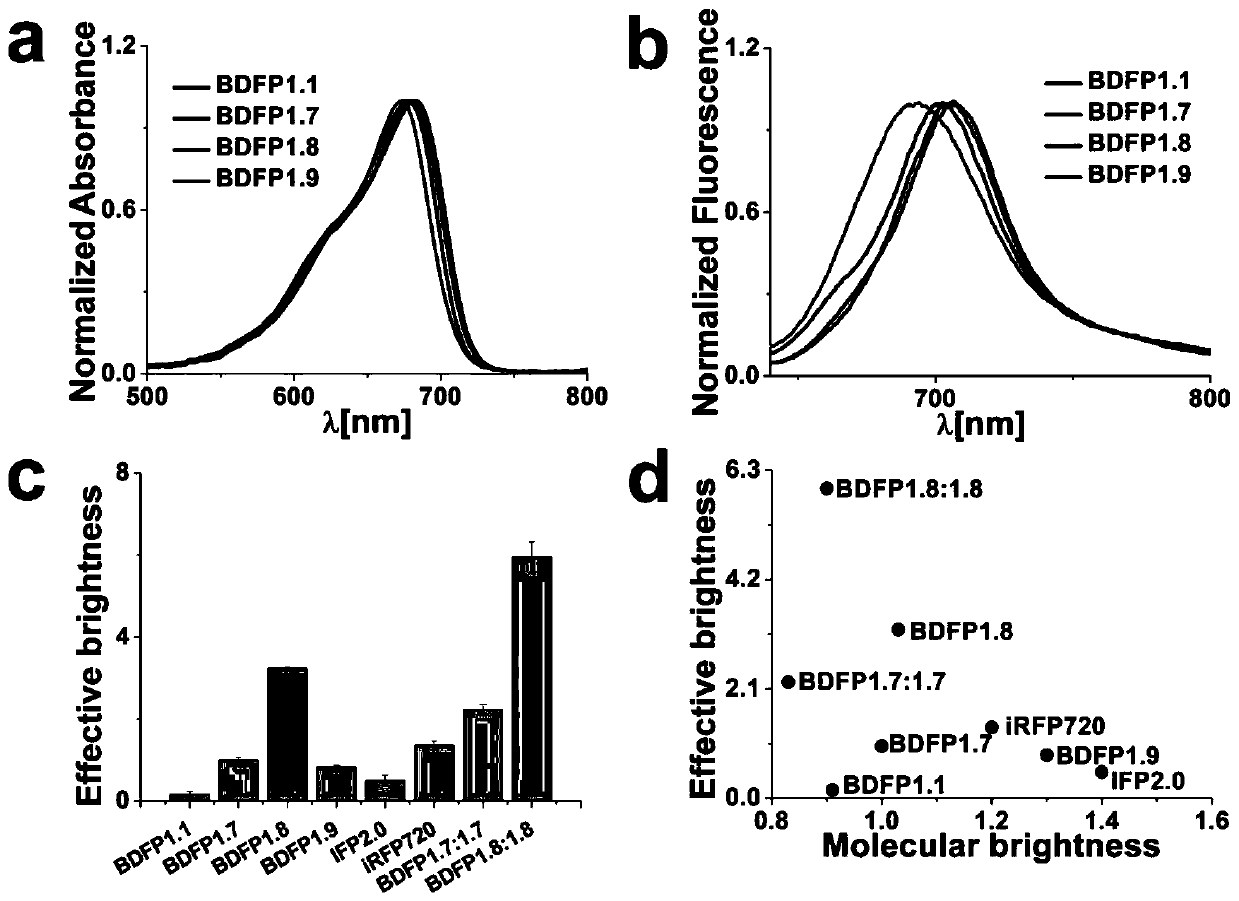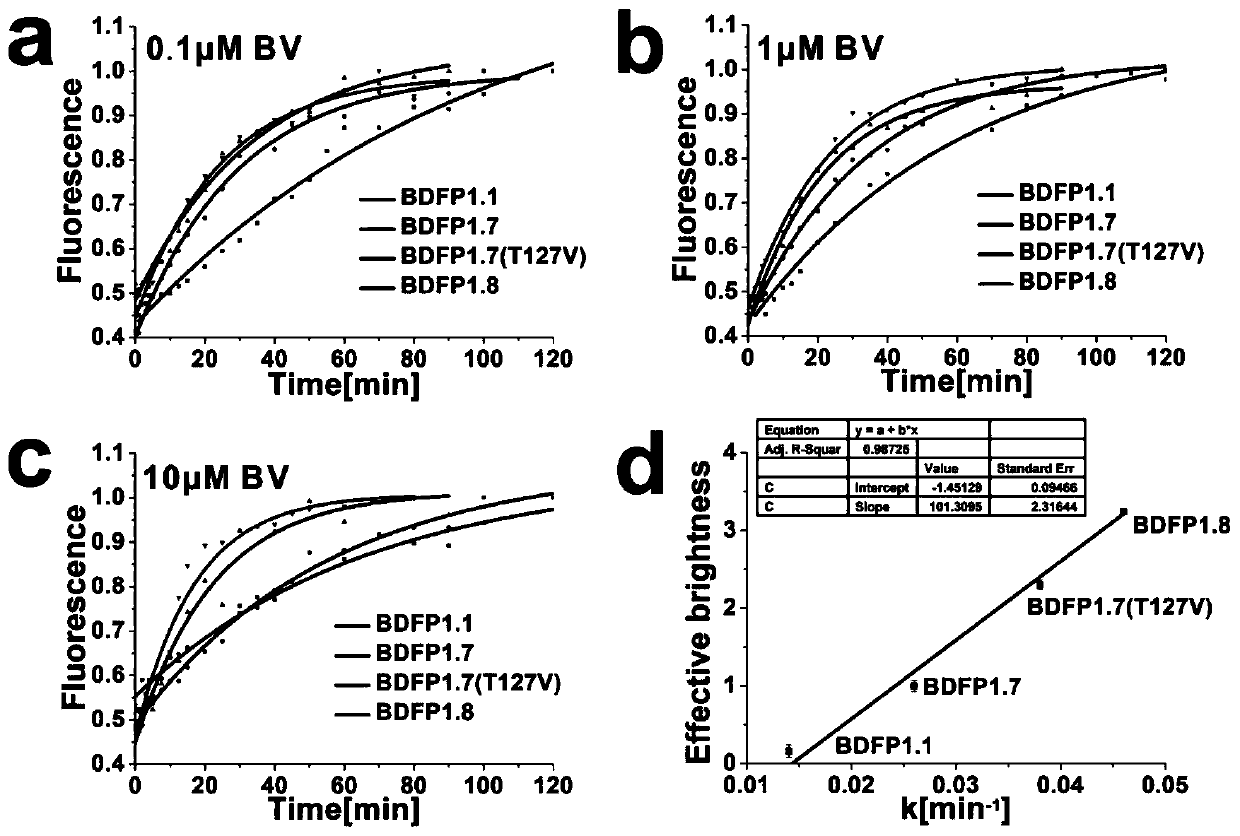Small molecular near-infrared fluorescent protein and fusion protein thereof
A fluorescent protein and near-infrared light technology, which is applied in the field of fluorescent markers, can solve the problems of insufficient brightness, large protein molecular weight, and few types of near-infrared fluorescent proteins, and achieves the effect of excellent stability.
- Summary
- Abstract
- Description
- Claims
- Application Information
AI Technical Summary
Problems solved by technology
Method used
Image
Examples
Embodiment 1BD
[0035] Vector construction, expression and property determination of embodiment 1 BDFPs mutant
[0036] Mutation starting template BDFP1.6 (SEQ ID NO.1, ie ApcF2(20-169)-
[0037] F30L / S46T / I51V / N72C / Y82C / Y92M / D101G / E107G / L109M / L113F / G125C / T127A / S130G / N136K / V143A / T151A / V160I / V161A / E163V) PCC720sp. Nuclear subunit protein ApcF2. BDFP1.6, evolved from BDFP1.1 (ApcF2(20-169)-S46T / I51V / N72C / Y82C / Y92M / N136K / V160I / V161A). The fluorescence range of BDFP1.6 is blue-shifted from near-infrared light to far-red light; especially its effective brightness is even better than that of commonly used iRFP670, while its molecular weight is only half of its size.
[0038] Through long-term creative research, it was found that the 113th, 125th and 127th amino acid residues have an important influence on the spectral properties of BDFPs protein. These residues in BDFP1.1 are leucine (L), glycine (G) and threonine (T), respectively, while phenylalanine (F), cysteine (C) in BDFP1.6 and alanine...
Embodiment 2BD
[0077] The stability of embodiment 2BDFPs mutant fluorescent protein
[0078] In this example, the resistance of fluorescent proteins to in vitro conditions, such as acid-base, denaturing conditions, high temperature, and photobleaching, was tested. The results are shown in Figure 6 middle.
[0079] Figure 6 (a) shows the stability of BDFPs, IFP2.0 and iRFP720 in pH2-9 acid-base environment, the fluorescence intensity of BDFPs only changes by 40% in the pH range from 9 to 2, while IFP2.0 at pH3. At 5 o'clock, the fluorescence of iRFP720 has been completely quenched at pH 2. This shows that BDFP1.9 is relatively stable at low pH, and has higher stability than IFP2.0 and iRFP720 under acidic conditions.
[0080] Figure 6 (b) shows the fluorescence intensities of BDFPs, IFP2.0 and iRFP720 in different concentrations of guanidine hydrochloride solutions. It can be seen from the figure that the fluorescence of IFP2.0, iRFP720 and BDFP1.1 has been completely quenched in 4M ...
PUM
 Login to View More
Login to View More Abstract
Description
Claims
Application Information
 Login to View More
Login to View More - R&D
- Intellectual Property
- Life Sciences
- Materials
- Tech Scout
- Unparalleled Data Quality
- Higher Quality Content
- 60% Fewer Hallucinations
Browse by: Latest US Patents, China's latest patents, Technical Efficacy Thesaurus, Application Domain, Technology Topic, Popular Technical Reports.
© 2025 PatSnap. All rights reserved.Legal|Privacy policy|Modern Slavery Act Transparency Statement|Sitemap|About US| Contact US: help@patsnap.com



